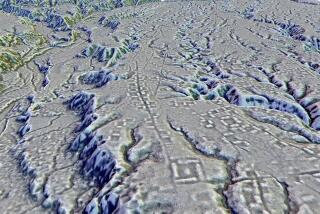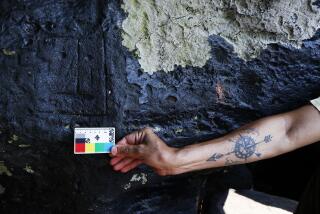Discovery May Be Site of Massacre by Conquistadors
- Share via
On a remote tip of the Dominican Republic, researchers believe they have discovered the site of one of the most brutal and bloody massacres of Native Americans by Spanish conquistadors.
The battle is well documented in Spanish texts, but the discovery of the remains of the settlement provides the first archeological documentation of the episode and of the peace-loving Taino people who lived there. Details of the expedition were revealed recently at a meeting of the Society for California Archeology in Rohnert Park, near Santa Rosa.
“This is the most important archeological discovery in the Caribbean in the last 25 to 50 years,” said Pedro Morales, head of East National Park, where the city was discovered.
Only 11 years after Columbus discovered the New World, a Spanish army led by legendary explorer Ponce de Leon and others destroyed the unnamed Taino settlement, slaughtering as many as 7,000 residents. The barbaric incident was one of the first in a 50-year period of conquest in which disease and slaughter wiped out the Taino population of more than a million on the island of Hispaniola.
Exploring the dense forest around a sinkhole so isolated that it could be reached only by mule trains or helicopters, the archeology team discovered four large ceremonial plazas and the remains of a city that once may have held tens of thousands of people.
“Our findings should yield priceless information about the first contact between the Spanish and the Indians in the New World,” said archeologist Charles Beeker of the Indiana University School of Health, Physical Education and Recreation, who led the expedition. “We had the Spanish record. Now we have the Tainal record.”
“Now we can measure historical accounts against archeological features,” added California state archeologist John W. Foster, who was part of the expedition. “That’s fairly rare in this region.”
Even though they were the first Native Americans to greet Columbus, the Taino are now largely forgotten. But before Columbus arrived, the Taino built a network of at least five independent kingdoms across the island, which now comprises the Dominican Republic and Haiti.
Skilled at agriculture and hunting, the Taino were also good sailors, canoe makers and navigators. In their cities, they built large plazas, surrounded by stone walls, where they held religious ceremonies, recited the news and played ball games that were similar to soccer.
The Taino left behind a few cultural reminders. The hammock, the musical instrument known as the maracas and the making of cassava bread were Taino (pronounced tah-EE-noh) innovations. The English word barbecue also comes from the Taino term for the rock slabs on which they baked bread.
The Taino are generally viewed as an unusually peaceful group, but their serenity had been disrupted 100 years before Columbus by an invading South American tribe called the Caribs. Fierce, warlike and sadistic, the cannibalistic Caribs raided Taino villages, capturing women for slaves and men for dinner.
The disruption of the Taino social structure by these incursions probably made it much easier for the Spanish to conquer them, scholars speculate.
Beeker and his colleagues have been exploring in the eastern Dominican Republic since 1993, looking for Columbus-era shipwrecks. Morales told them about a cave in the area that contained pictographs and suggested they investigate it.
Helicoptered in by the Dominican air force, the scientists discovered an 18-foot mural on the cave walls commemorating the signing of a treaty under which the Spanish purchased bread from the Taino. The elaborate display even showed the Spanish galleons that shipped the bread to nearby Santo Domingo. Other pictographs showed Taino daily life.
But the real find was a nearby sinkhole harboring a fresh-water well, although getting to it was a problem. The crew had to pass through a narrow opening on the surface and rappel 50 feet to the water, then dive from an inflatable boat through 140 feet of water to reach the artifacts.
“I’ve been diving for 35 years, but I had never rappelled in my life,” Beeker said. After a short preliminary investigation, he returned to the United States and enrolled the team in a rappelling class before revisiting the site, called Manantial de la Aleta in November and again in March.
The team made about 80 dives in the well, Foster said. Because of the depth, each person was limited to only 11 minutes on the bottom each time.
“We were shocked at the amount of ceramics and the diversity of other things we found,” Beeker said.
Team members recovered baskets, wooden war clubs, carved and decorated gourds, and a variety of pottery--one piece of which clearly showed a melding of Taino and Spanish styles. And because of the depth of the water and the lack of oxygen, all of the items were remarkably well preserved.
One of the prized artifacts is an incised gourd that is intricately carved with a precise design. It is the first ever recovered from the Dominican Republic, Beeker said, and may be unique to the Caribbean.
The team also found parts of a carved wooden stool called a duho that is the symbol of Taino royalty. The chief of the tribe was always seen in public seated on his or her duho.
The items “include some of the most elaborate artifacts that the Taino made, and we were puzzled as to how they could have been thrown down this hole and deposited in the water,” Foster said. “In one or two cases, they even contain food remains. They are more consistent with the idea of offerings and ceremonies.”
The team thus believes that the well was not a garbage dump but rather a ceremonial well, called a cenote, where the Taino made sacrifices to their gods. Although such cenotes are not rare in South and Central America, this was the first Taino cenote discovered.
The importance of the ceremonial well suggested that there must have been a settlement nearby and, in the most recent visit, the team began scouting through the dense forest and brush for signs of it. The first hint was found by Indiana sophomore Chris Gonso, who was looking for deposits of shells and encountered a snake instead.
“I was kind of running from that and got on top of a pile of rocks,” Gonso said. “Then I noticed it was a long line of rocks.” The rocks turned out to be the walls of a ceremonial plaza.
The team found two other plazas, each about 75 yards long and 15 yards wide, on that expedition. Dominican archeologist Marcio Veloz Maggiolo recently found a fourth. The presence of so many plazas, Beeker said, suggests that the site was a sizable and important city.
The expedition also found kitchen areas and stones used to break and grind oyster shells. Some of the stone depressions still had bits of shell left in them, as though the city had been simply abandoned. “They could have just walked off last week,” Beeker said.
The team now believes the city was the site of a 1503 massacre reported by the Spanish missionary Bartolome de las Casas. That incident marked one of the first major clashes between the Taino and the Spaniards, and set the Indians on the path to eventual annihilation.
The missionary described watching Taino loading bread onto a Spanish galleon--fulfilling the treaty commemorated in the nearby cave. A Spanish officer standing nearby had an attack dog on a leash, and when the dog began acting up, a nearby officer jokingly suggested that the dog attack one of the Indians.
“Tomalo!” he said. “Take him!”
The dog escaped from his handler and disemboweled the Taino, who happened to be a minor chieftain. The Indians retaliated later by killing a few Spaniards.
In response, the Spanish garrison at Santo Domingo sent an expedition against the city. In a major battle, they killed as many as 7,000 of the Taino inhabitants and ran others off into the forest. They cut the hands off those they captured and lined the bodies up in long rows.
“That city was never a problem again,” Beeker said.
(BEGIN TEXT OF INFOBOX / INFOGRAPHIC)
Artifacts of a Lost Tribe
Researchers believe they have discovered artifacts from a lost tribe of Native Americans. Exploring in the Dominican Republic at an isolated sinkhole, the team of divers and other researchers have found four large ceremonial plazas and the remains of a city that once may have held tens of thousands of people.
More to Read
Sign up for Essential California
The most important California stories and recommendations in your inbox every morning.
You may occasionally receive promotional content from the Los Angeles Times.










